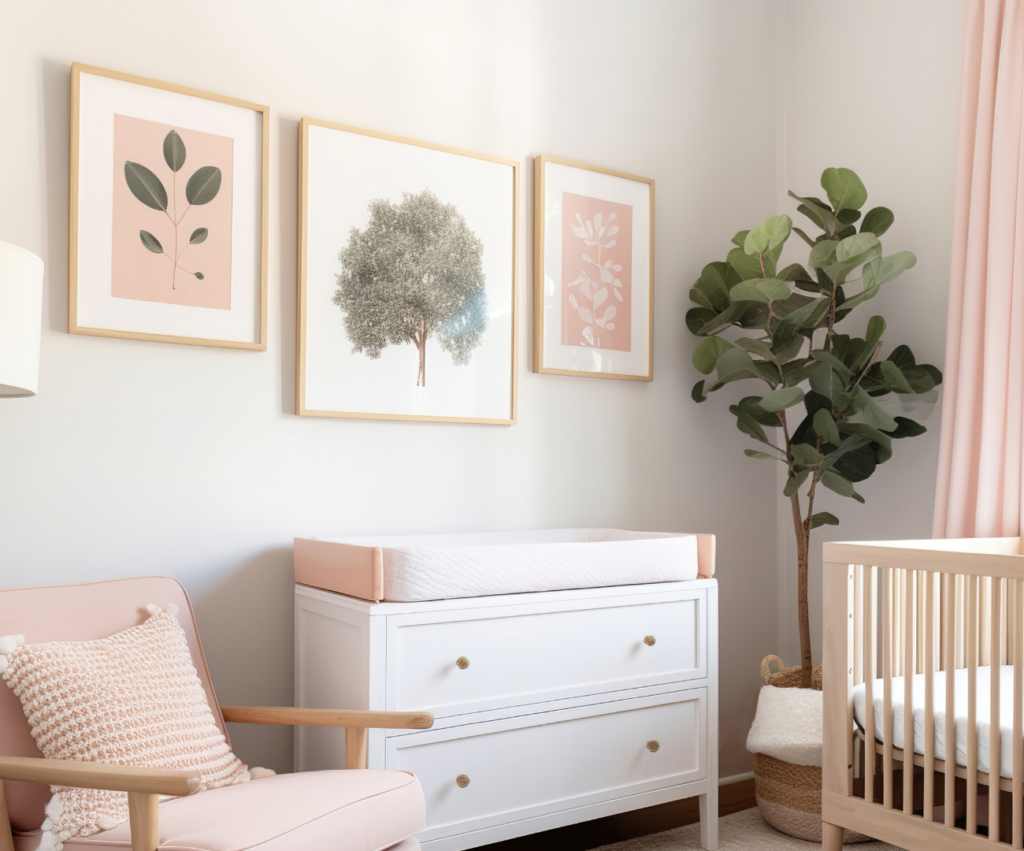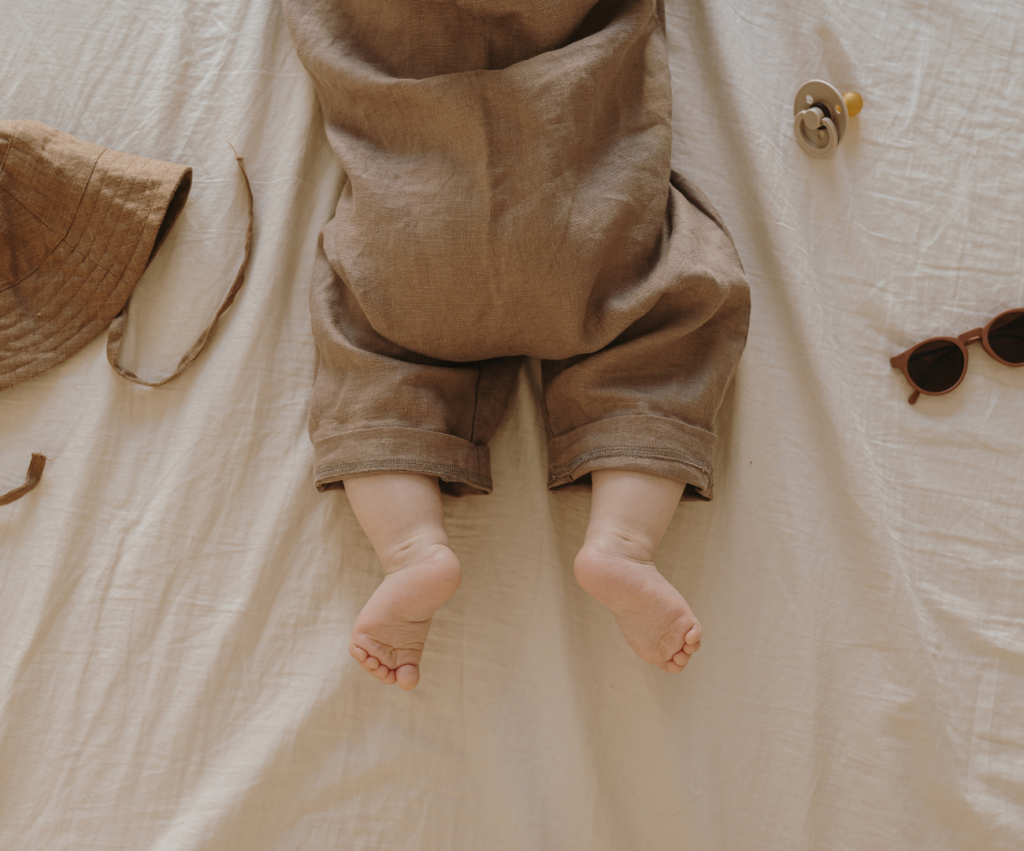You will spend most of your time with your baby in your nursery, so it should be a safe and healthy place for both of you. Additionally, you should consider how the space will evolve as your baby grows.
Here are some great tips for building a nursery that’s healthy, practical, and as non-toxic as possible.
Tips for creating your non-toxic nursery
1. Use non-toxic paint
Painting is often the first thing would-be parents do when creating their nursery. As you choose your color palette, look for paints with no volatile organic compounds (VOCs).
These are gases that can harm your health and cause symptoms such as dizziness, headaches, nausea, fatigue, and more.
Even though you see those cute scenes in movies where the pregnant mom paints the nursery, that’s not advisable in real life. Even paints labeled “VOC-free” can have trace amounts, so it is better to err on the side of caution.
Have someone you trust to paint your nursery in your color of choice. Ideally, they should do it months before the baby comes.
2. Opt for safe flooring and floor coverings (like rugs!)
As your baby learns to crawl and walk, they’ll spend plenty of time on the floor. Your choice of flooring is crucial to keeping your baby healthy.
Kids will always make messes — it’s part of growing up. For this reason, try to avoid using carpets for your nursery. They can be a breeding ground for bacteria, as spot-cleaning messes is complicated.
Also, your baby can be exposed to VOCs (yes, like from the paint) from the carpet’s adhesive backing and treatment.
Of course, you want your baby to have a soft place to crawl around and play. Ideally, choose a washable, non-toxic rug. It will be much easier to clean out stains and dirt so your baby can stay safe from bacteria and other harmful substances.

3. Choose practical furniture
Babies grow pretty fast. Before you know it, they’re taking their first steps. Time can fly by with your little one, so you should be ready to transform your nursery to meet their needs at every stage.
A great way to do that is through convertible furniture. Your baby won’t need a crib for long, so invest in cribs that convert into a toddler bed. There are ones that have adjustable rails and mattress heights to help your child as they grow.
- Convertible crib
- Convertible changing table
Another practical piece of furniture you can invest in is a convertible changing table. Once your baby is potty trained, you can take out the top part and have the rest of the bottom as storage.
When you choose furniture, ensure its paint or finish is VOC-free. Children can and will bite into surfaces, so everything must be non-toxic.
Pro tip: Secure all furniture in your nursery and, ideally, your home. Tip-over accidents do happen, so anchoring your furniture is necessary. This includes bookcases, dressers, changing tables, televisions, and more.
A simple anchoring kit (pack of ten here) and a few extra minutes can help put your mind at ease and help ensure your baby’s safety.
4. Pick the right colors
Choosing colors for your nursery goes beyond aesthetics — according to color theory, varying shades can affect you and your baby psychologically.
Some are calming, while others are more stimulating. For instance, shades of blue and green can help with sleep. Meanwhile, bright yellows and oranges can help boost mood and promote creativity.
You can incorporate colors into your nursery using paint, wallpaper, furniture, and drapes.
However, remember to choose more soothing tones. You may not notice how subtle the paint’s effects are, but you’ll experience it once you walk into your baby’s calming blue nursery late at night.
5. Keep the air clean
Believe it or not, indoor air can be more polluted than outdoor air, even in industrialized cities. If you don’t properly ventilate an indoor space, pollutants can stay trapped in the air you breathe.
Since you’ll spend a lot of time with your baby in your nursery, you should focus on keeping the air clean. That way, you can protect yourself and your child from bacteria, mold spores, dirt, and other pollutants.
Periodically ventilate your nursery by opening doors and windows. Let fresh air enter and dirty air exit for a few hours. You can also keep your nursery air cleaner by using an air purifier with a HEPA filter.
Don’t forget to order extra filters and switch them out when they get too dirty.
6. Control the lighting
Lighting in your nursery can benefit your baby’s health. In the morning, let some natural light in. Doing so can help regulate your child’s circadian rhythm and promote sleep at night.
However, don’t let harmful UV rays hit your baby directly. Keep the crib away from direct sunlight, and invest in some good curtains. Use sheer curtains to soften sunlight in the day and blackout ones when it’s time for an afternoon nap.
Install some high-quality night lights for when your little one cries at midnight. Get one with a dimmer so you can see where you’re going without startling your child with a striking, bright light.
7. Choose non-toxic and organic baby products
Unfortunately, we now know how harmful certain popular baby products can be. If you aim to create a non-toxic nursery, don’t overlook this critical component.
Opting for non-toxic baby care products will help limit the overall number of toxic chemicals absorbed into your baby’s skin, and every little effort helps.
8. Pick a chemical-free mattress
The more you learn about baby mattresses, the more you’ll understand why it’s important to choose one free from harmful chemicals. Harmful chemicals like flame retardants and VOCs can be inhaled by your baby, and the mattresses tend to be more hypoallergenic, breathable, and environmentally friendly.

Create the perfect space for you and your baby
Your baby’s nursery is where your parenthood journey begins. This space you’ll share with your little one will house many memories of their early years. Creating a healthy nursery will help your baby grow in a safe environment.
Meanwhile, making practical choices can help you cope with the fast-moving changes during your child’s infant and toddler years, and knowing your baby’s nursery is as non-toxic as possible can help.
